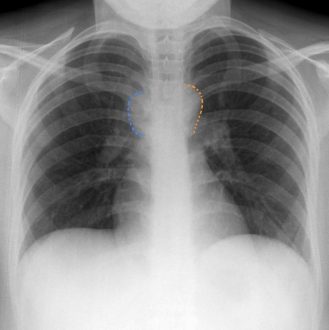Lymph nodes are the small bean-shaped structures responsible for the immunity of the body. These lymph nodes must filter those substances that pass through the lymphatic fluid. The lymph nodes contain lymphocytes or white blood cells. These lymphocytes present in the lymph nodes are responsible for the body’s protection against infection and disease.
Out of various lymph nodes present, precarinal lymph nodes are also the one. The precarinal lymph nodes are present within the chest cavity around the human lungs. Their function is to trap cancer and bacterial cells and ensure immunity in the pulmonary region. The precarinal lymph nodes may extend their usual size in some individuals. The enlargement of these pulmonary nodes is most frequently associated with lung cancer, tuberculosis, and a condition known as obstructive pulmonary disease or COPD. Such a condition where size and consistency are abnormal in the lymph nodes is known as lymphadenopathy, producing enlarged or swollen lymph nodes.
Precarinal Lymph Node Location
There are several lymph nodes present in the human body. That list of lymph nodes includes cervical lymph nodes in the neck region, axillary lymph nodes in the armpit, and inguinal ones in the groin.
The location of precarinal lymph nodes in the body is the pericardial space. This space is present in the chest and is surrounded; by the ascending aorta, the left and right arteries, and tracheal bifurcation. In a few cases, lymph nodes may also falsify causing, intense pain in the pulmonary region. Calcifications in the lymph nodes result from prior granulomatous infections, particularly histoplasmosis and tuberculosis. However, it also includes some less common causes. Those less common causes include amyloidosis, sarcoidosis, silicosis, and secondary calcification to the lymphomas treatment. The patient exhibits precarinal lymph nodes enlargement with features that make them more specific. These clarifications involve multiple chains of lymph nodes that include some that present eggshell calcification.
Precarinal Lymph Node Size
Precarinal lymph nodes have a size of less than 10 mm in diameter. However, there are cases in which these lymph nodes enlarge themselves and exceed the usual size mentioned above. Now, what is the probability of that? According to one study, 60 of the 90 observed patients had normal-sized precarinal lymph nodes; less than 10 mm in diameter. What about the other 30 cases? The remaining 30 had enlarged precarinal nodes on CT scan, which were greater than 15 mm from the diameter point of view. Lymphadenopathy is visible in the precarinal lymph nodes that are present within the chest cavity around the lungs. The term used for the swollen lymph nodes in the chest is Mediastinal lymphadenopathy. These swollen lymph nodes appear specifically in the area between the lungs containing the heart, trachea, and esophagus or specifically the mediastinum. It is a sign of an underlying disease or infection.
Precarinal Lymph Node Enlargement
Enlargement of precarinal lymph nodes or mediastinal lymph nodes may occur from a wide range of pathologies. The wide range of pathologies may involve its own or its association with any other lung pathology. Historically, a size cut-off of 10 mm short-axis diameter was employed.
The terms mediastinal lymph node enlargement and mediastinal lymphadenopathy are not the same. Various enlarged mediastinal nodes will be pathological, but not all will be. Conversely, few mediastinal lymphadenopathies will be visible in non-enlarged nodes. For this reason, the diagnostic waters are muddied as some pathologies produce via reactive change the nodal enlargement and not because the pathology itself infiltrates the node. The broad spectrum of conditions resulting from mediastinal lymphadenopathy is diverse. It includes sarcoidosis, primary lung cancer, metastatic malignancies to the mediastinum from other sites. The frequent conditions involve oesophageal, breast, and thyroid cancer. However, the less common conditions are malignant pleural mesothelioma and thymic epithelial tumor.
Precarinal Lymph Node Cancer
The lymph nodes may be susceptible to cancers. The same goes for the precarinal lymph nodes. Cancer in the lymph nodes may occur in either of the ways. Cancer that begins in the lymph nodes is known as lymphoma. It is of two types; Non-Hodgkin’s and Hodgkin’s. Another way, it starts somewhere else in the body and then spreads to the lymph nodes; it is more common.
The causes of both kinds of lymphoma include genetic mutations, chronic infections, autoimmune diseases, changes in the immune system, immune deficiencies. These cancerous lymph nodes are difficult to diagnose because of their tiny size. When there are only a few cancer cells, the only way to check for the cancerous precarinal lymph nodes is to remove all or part of the lymph node. A biopsy is the removal of one lymph node. The other way is to perform lymph node sampling or lymph node dissection to remove multiple lymph nodes.
 Health & Care Information
Health & Care Information 


